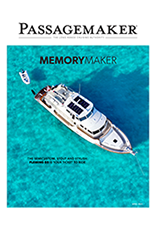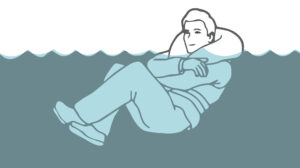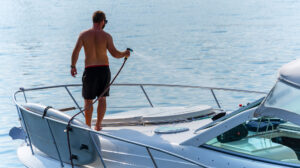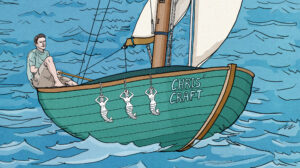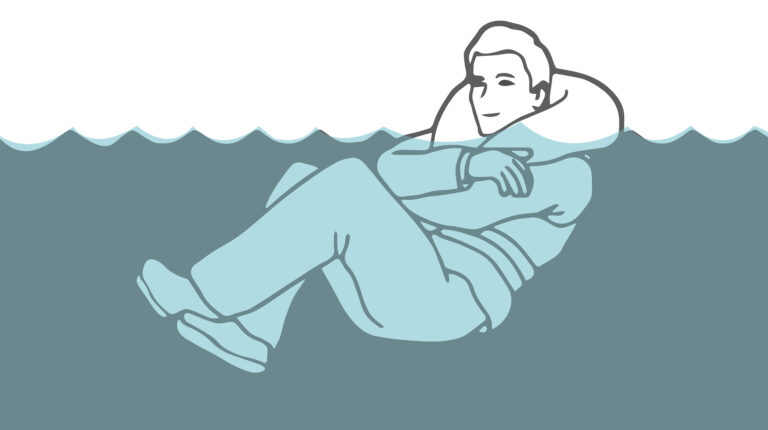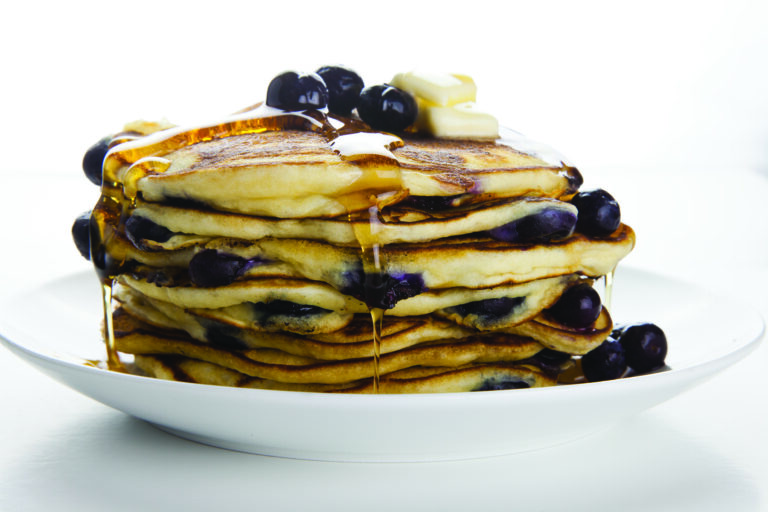Everything was new and untried, including us, when in 1995 Hurricane Opal, our first hurricane, showed up. Once the hurricane warning was issued, we debated as to what we would do, finally deciding to ride this storm out at anchor. But, having waited too long, we found ourselves in 30-knot winds, reefed down, struggling to sail our engineless 36-foot cutter out of the marina. Fortunately, our escape, though somewhat harrowing, was successful. We located a place to anchor, rigged and deployed our gear, then we settled back to worry, wondering if our preparations would be adequate. This storm certainly knew how to cut short the thrill we were experiencing from having launched our boat a few weeks earlier.
In spite of our naivety, our boat survived without any damage, and we survived, suffering only from anxiety and sensory overload. When we returned to the marina, our decision to anchor was validated when we saw that the marina and the boats that had remained sustained damage, much of it extensive.
This certainly was not the maiden voyage that we had envisioned four years earlier when we started to build this boat, and anchoring in a hurricane was not a dream of ours either, but this storm did pique our interest in the “hows,” “whys,” and “what-not-to-dos” in anchoring.
It was during this storm, as we watched the amount of stretch occurring in our snubber, that we became alarmed. Mother Nature was trying to use the same technique to sever our snubbers that we would use-stretch them tight and commence cutting and the tighter the rope, the easier it is to cut. We realized that it would be extremely beneficial if we could discover what the lowest limit for stretch is in a snubber while still maintaining its effectiveness; the classic conundrum of snubbers-strength vs. stretch.
Snubbers, or riding stoppers, are wonderful creatures. Being just pieces of rope, they are the epitome of simplicity, but like their cousins, anchor ropes and docklines, they are just as important, but for different reasons. One function that a snubber performs is to act as a cushion. The action of the waves or seas against the boat creates intermittent, repetitive, and often jarring loads, called shock loads, on the ground tackle. These shock loads, which are also referred to as surge loads, are significant since they can as much as double the force on the ground tackle over that created by the wind alone. The use of a snubber will cushion these shock loads, preventing the boat from fetching up hard when the catenary in the rode disappears.
Protecting the windlass is another function that a snubber performs. A windlass’s mechanism is not designed to handle the loads incurred by a boat at anchor, and can be damaged if made to do so. But by hitching a snubber to the rode, belaying the snubber’s bitter end to a cleat (or samson post or bitt), then easing off on the rode, the load is removed from the windlass’s wildcat or gypsy (warping drum), which will prevent the windlass’s mechanism from being overloaded and broken.
A snubber can also function as a safety feature. The snubber, being tighter than the rode, will be the component prone to chafe. Should the snubber part, the rode, still attached, will prevent the boat, at least for a time, from breaking free.
Lastly, by securing a snubber elsewhere from where the anchor rode is belayed, a redundancy is created so that if one of these two points should fail, the boat will continue to be held by the other.
For a snubber to perform these functions effectively, it must have several features: adequate stretch, ample length, sufficient strength, and interwoven among these three, the ability to resist chafe and melting.
Stretch
Stretch is the feature that cushions shock loads, and the lack of stretch in a chain or any other “low-stretch” rode is the reason they require the use of a snubber. But stretch is a double-edged sword: it also makes the snubber vulnerable to chafe and melting.
Chafe occurs when the snubber rubs on something and is exacerbated if the snubber is stretched tighter, more vigorously, or if there is a hard or sharp edge under it. But not every snubber that parts does so because of chafe. Stretch also creates friction among the rope’s fibers and this friction can generate enough heat to melt the fibers. When melted, the fibers form little, hard, sharp nodules, just as if a flame was held to them. If the snubber has not yet parted, these nodules then chafe adjacent fibers almost assuring that the snubber will part.
Length
A second feature that contributes to a snubber’s performance is length. Long snubbers stretch farther than short snubbers, enabling them to cushion shock loads better. Our preference is to use snubbers that are 30/40 feet in length, and for severe weather, particularly if the rode is made from a low-stretch material like chain, we will use snubbers that are even longer.
In mild weather, we usually veer about 15 feet of the snubber, and in a few situations, we may veer even less, but anytime the crew will be unavailable to ease off on the snubber, we avoid “snubbing short” like the plague.
Another benefit of long snubbers, unrelated to anchoring, is that they can do double duty as docking lines. Long lines dramatically increase their “catchability,” so if the folks on the dock are not catching your lines, try throwing longer lines (30/40 footers) and see if their skill doesn’t improve!
Strength
Strength is the feature that enables components to resist being deformed or broken, and the philosophy found in that Olde Maine proverb, “nothing too strong ever broke” is well suited to anchoring. There are a few books (Earl Hinz’s The Complete Book of Anchoring and Mooring [Cornell Maritime Press, Inc.], for one) that have charts, tables, or formulas that can be used to calculate the minimum strength required for the components used for anchoring. To determine what minimum strength is needed, start by determining what the wind’s force will be on the boat (using the highest wind speed that might be encountered), adjust this amount for shock loads (multiply the wind’s force by two), and multiply this result by four (manufacturers of chain, shackles, and swivels recommend this safety factor).
Although this method eliminates guessing at what minimum strength is required, when sizing components, it applies only to loads in straight-line pull. When a boat veers, bending or side loading is imposed on the boat’s anchors, fittings, and other related gear, decreasing their breaking point by as much as 50 percent. Therefore, bending or side loading should be avoided, unless the additional strength required to resist this type of loading has been included in the calculations and the components are sized and installed accordingly.
Loading
But sizing a snubber needs to be approached differently from “hard” components, since stretch, chafe, and melting-factors that do not affect “hard” components-do affect snubbers. While some literature indicates that rope, and by association snubbers, can be subjected to loads up to 50 percent of their tensile strength, this much loading needs to be avoided and the following points illustrate the reasons for this:
When the load on three-strand nylon rope exceeds 15 percent of its tensile strength, damage to the rope’s fibers starts to occur and the greater the strain or the longer the strain is applied, the greater the damage. At 50 percent loading, even if the rope has not yet failed, it’s likely that it will need to be replaced.
Fifty percent loading brings three-strand nylon rope close to, or even past its point of failure due to an accumulation of factors that are introduced into the rope, which reduces its strength: splices by 5/15 percent, knots by 2545 percent, wetness by 8/15 percent, and heat from 0/100 percent. (Steve Parola at New England Ropes explained that three-strand nylon rope loses 30 percent of its strength by the time it reaches 300°F and continues losing strength until it melts at 460°F.) Sharp turns, tight bends, chafe, dirt, aging, kinks, and hockles further weaken the rope. Finally, at 50 percent loading, the stretch that occurs in the rope is severe enough that chafe or melting can occur so swiftly that a response to counter it is often not possible.
So, it can be seen that when a knot or splice, wetness from rain (or immersion in the sea), heat from stretching, repeated rubbing over a chock or a sharp bend in its lead, and some aging are introduced into a snubber, which is then stretched to 50-percent loading, it has surpassed the point where it can be trusted not to part. Also, do not forget how easily a snubber can chafe or melt under this load. No wonder some boats break free!
It’s clear that the load on a snubber must be kept well below 50 percent of the rope’s tensile strength and the only way to do this is to lower the snubber’s percentage of loading. The only way to lower the snubber’s percentage of loading is to make it bigger, thus stronger. By increasing the snubber’s size, it also becomes less susceptible to chafe and melting, a very desirable trait in a snubber. But, how strong can the snubber be and still retain adequate stretch?
We contacted a variety of rope manufacturers and they all recommended that the load on three-strand nylon rope be kept below 15 percent of the rope’s tensile strength. But, at the same time, they were averse to rendering an opinion as to whether this amount of loading would provide adequate stretch for a snubber. We could not fault the manufacturers in taking this stance, since this is not their province; but as we continued to see snubbers, anchor rodes, and docklines fail, we were certain there had to be a way to size these lines that would make failure less likely. As we continued looking for a solution, the answer slowly dawned on us, evolving from the following points:
Snubbers fail because they chafe or melt; the result of being stretched. While other factors are often present, they don’t seem to be the cause.
It is the snubber’s strength that is used to resist the force of the wind, and even though there is stretch involved, the stretch is relatively constant, changing only as the speed of the wind changes. This type of stretch contributes little, or nothing, to chafe and melting.
Once the snubber is pre-loaded by the wind, the force of the waves acting against the boat causes shock loads, but also creates additional stretch that cushions the shock loads. This surging of the waves also causes the snubber to constantly stretch and relax, and it’s this type of stretching that makes the snubber vulnerable to chafe and melting.
When the amount of stretch that is needed to adequately cushion shock loads is exceeded, the snubber is exposed to the possibility of chafe or melting that otherwise could have been avoided.
When the load on three-strand nylon rope remains below 15 percent of the rope’s tensile strength, the stretch that occurs is from the removal of the slack that exists between the rope’s fibers (referred to as construction slack) and this causes no damage to the rope. Once this point is exceeded, any additional stretch that takes place stretches the rope’s fibers, damaging them. The greater the stretch, the greater the damage.
Three-strand nylon rope, at 7-percent loading has 10-percent stretch, and at 15-percent loading, has 15-percent stretch. (These figures are provided by New England Ropes; other manufacturers’ figures may differ, but when they do, we find that they remain proportionally similar.)
If a snubber is sized so that the wind-induced load does not exceed 7 percent of the rope’s tensile strength, and since the wave-induced loads can, at most, only double the load on the snubber, the total load on the snubber will not exceed 15 percent. This gives a differential in stretch of up to 5 percent, and this 5-percent stretch is what cushions shock loads; at the same time the snubber is not loaded beyond the point where the rope’s fibers will be damaged by the stretch that occurs.
At 20- and 30-percent loading, the differential in stretch, between the wind load and the wave’s load (that stretch which is used to cushion shock loads), is essentially the same as that at 15-percent loading. This higher loading only places the snubber at greater risk for chafe, melting, and fiber damage, with little or no additional ability to cushion shock loads.
Longer, but thicker, snubbers contribute to stretch far more safely than do thinner, but shorter, snubbers.
One thick snubber resists chafe better than two thinner snubbers. Plus, it’s unlikely that two snubbers can be installed so that they load equally. (Although, for heavy weather, it’s wise to install a second, back-up snubber.) Thicker snubbers also have more tolerance for strains that become greater than what was anticipated. And the clincher-we could not recall having seen a single boat that had problems because a snubber was “too big.” We cannot say the same about the opposite.
High Strength-Low Stretch
These points suggested that better results could be had using a “high strength-low stretch” approach and this we could not ignore. We then sized our snubbers so their maximum loading (including both the wind force and shock loads) would not exceed 15 percent of the snubber’s tensile strength. (The stronger the wind, so to must be the snubber.)
We have been using this method for sizing our snubbers (rope rodes and docklines, also) for the past 12 years. We have had the opportunity to use our snubbers, sized in this manner, in mild conditions; through countless storms, gales, and squalls; and during six hurricanes, four with 120-knot winds. When we switched from our sailboat to a 34-foot, 28,000-pound, sail-assisted trawler, we brought this “high strength-low stretch” approach with us and continued to use it.
In all of these conditions and on both boats, we have seen the same results: greater strength, less stretch, longer lifespans, and significantly greater resistance to chafe and melting (they still need anti-chafe gear), all while retaining sufficient stretch to cushion shock loads. An additional benefit from using this approach is that a snubber will never fail from being too thin. For us, we consider this a win-win-win situation.
Please take note that although stretch in the snubber attenuates the speed of loading and shortens the duration of maximum loading, it does not significantly reduce the amount of loading. So even with the use of a snubber, the rest of the gear and fittings still need to be capable of handling the maximum loads that can occur.
Insufficient stretch is often cited as a reason that anchors trip, but we think otherwise and do not believe it is a valid reason to risk using a snubber loaded beyond 15 percent of its tensile strength. On those occasions when this claim was made and we were able to evaluate the circumstances, we concluded that one or more of the following was more likely the cause: the anchor was too small for the conditions; the particular anchor design used held poorly in the type of bottom it was used in; the amount of scope used was too short; or multiple anchors were not deployed, and when the wind or current changed direction, the single anchor was of a type that was unable to hold or reset.
Unfortunately, this “high strength-low stretch” approach cannot be implemented on every boat, since some boats have fittings that are too small to accommodate the size rope that is better suited for severe weather. However, the solution is simple: these fittings should be upgraded. If hefty enough fittings are not available from a chandlery, a machine shop or welder can usually make up something that will work; just make sure to smooth all surfaces that the rope will touch.
While perusing charts that are used for sizing rodes, anchors, and chain, boaters may miss the disclaimer, often written in small print: “For use when the wind is less than 30 knots with protection from seas.” (In our experience this means less than one-quarter-mile fetch). If this disclaimer is overlooked or it is missing from the charts, an inadequate snubber may inadvertently be chosen. The presence of or potential for conditions more severe than what is stated in the disclaimer requires heftier gear.
Anchor Trouble
Certain anchor designs are susceptible to damage from side (or bending) loads, but when sized to resist this type of loading, they can be too big or too heavy for the crew to handle. If these designs, in crew-manageable sizes, are used in veering situations, multiple anchors should be deployed in such a manner that none of them would receive enough side loading to cause them to break or deform. Since the load will, at times, be concentrated only on one anchor, each of these anchors must be of a size and of a design that is capable of holding the boat on its own.
It’s because we have seen so many boats that break loose or drag, that we believe thefirst anchor for a boat, and all its related gear and fittings, should be sized to be big enough and strong enough to handle the most severe conditions that the boat can encounter, and, there should be no hesitation to use it. In addition, the anchor’s design must be chosen to “not fail” in the particular bottom that it will be used in. Only after the “big stuff” is on board should gear be chosen that is suited for milder conditions or for convenience.
Although boats are outfitted differently, depending on their location, use, and specific circumstances, one fact remains applicable to all boats: they need to withstand the rigors of anchoring. As a general rule when anchoring, conservative measures work best. Use bigger, not smaller; longer, not shorter; heavier, not lighter; and do it sooner, not later.
